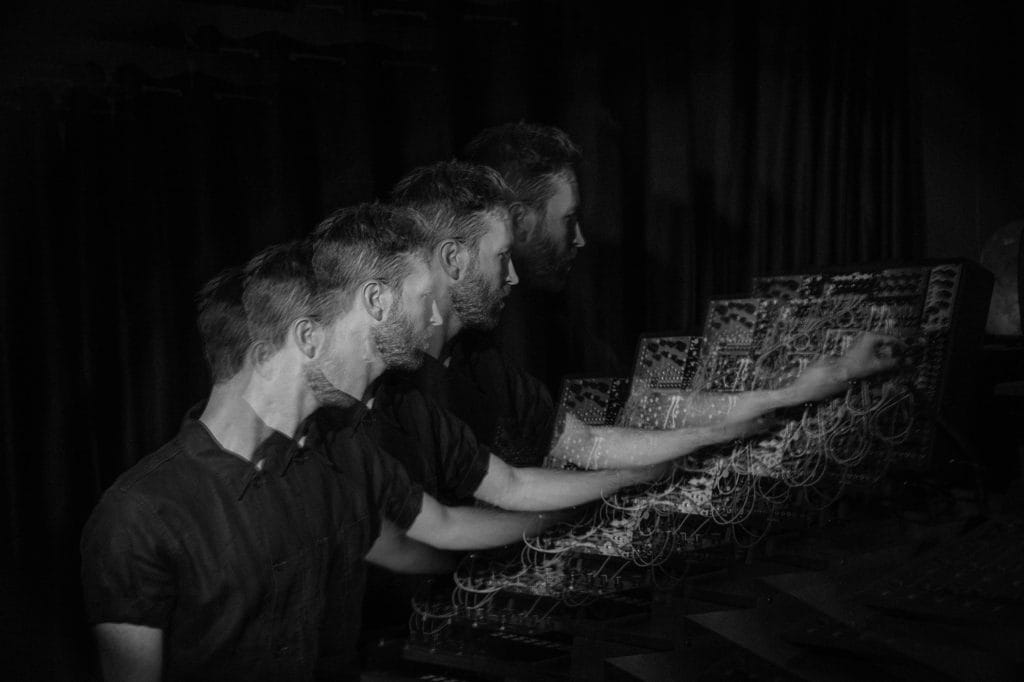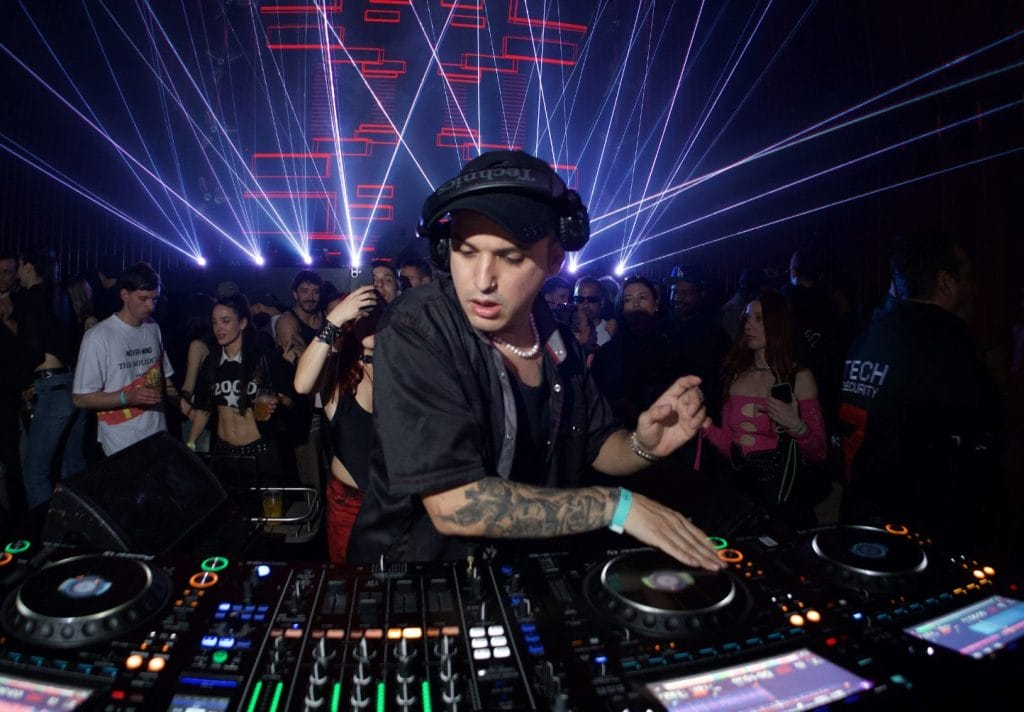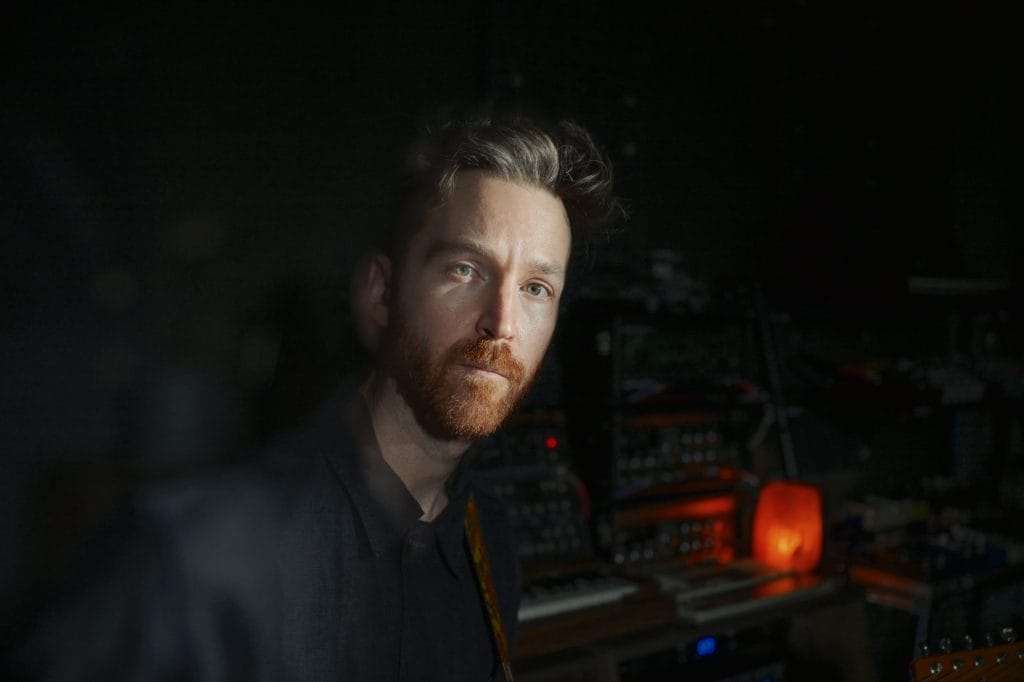Austin-based ambient composer TJ Dumser, known as Six Missing has announced his new full-length album, Without Mind, which dropped August 8 via Nettwerk. The was unveiled in parts, starting with Without Mind: Identify, available now. Originally crafted as an improvised soundtrack for ketamine-assisted therapy sessions, these recordings grew into a cohesive body of work designed for deep listening and self-reflection. The first installment features four tracks tied to specific times of day, each paired with a guiding mantra, from the early-morning intention of “Try Too” to the midnight meditation of “Become Am.”
Built on eurorack modular systems, a Moog Matriarch, and a Minimoog, Dumser’s process captures the spontaneity of live performance while creating sonic environments meant to be fully experienced. Since launching Six Missing in 2017, he has collaborated with Kaitlyn Aurelia Smith, St. Lucia, Ann Annie, Jamie Lidell, and others, while earning recognition from outlets such as Headphone Commute, CLASH, and Inverted Audio. With Without Mind, Dumser delivers his most refined work to date, encouraging listeners to approach the music with intention and presence.
In the conversation that follows, Dumser shares how his creative environment, movement habits, and hands-on approach to gear shape his compositions. From the physical layout of his backyard-built studio to his philosophy on slowing down, his insights reveal the same focus and openness that define Without Mind. The interview offers a closer look at the daily practices and creative choices behind an album designed to guide listeners inward.
Q: Do you move around a lot during sessions, or are you more locked into your chair once you’re in it?
This is a great question! I tend to do most of my moving before and after a writing or recording session. It’s a way to expend energy and then “settle in” — to ground myself and open up to whatever random magic might unfold. And by magic, I usually mean noodling on a synth or a piece of gear until something catches my ear — something that feels like it’s motioning to me, beckoning me to come closer and explore.
One of the best investments I’ve made in the past decade is my Herman Miller Aeron chair. It’s the studio chair. Definitely the most I’ve ever spent on a chair, but I’ve been sitting in them since my first internship, and it’s become a kind of essential tool for me. You never know if a session is going to stay loose or spiral into something deeper, so you need something supportive and comfortable. The ergonomics make me feel almost weightless. I really believe that staying upright and supported helps your mind stay open and aware — not slouching into sleepiness or distraction.
Okay, one more thing about the chair, ha — sometimes I get so locked in that I’ll realize I haven’t stood in over an hour and a half. That kind of uninterrupted flow is rare, and crucial for me. When it happens, I try to let it.
Q: Have you found that certain gear setups encourage more physical interaction or flow?
Yes, absolutely. I think of my studio as one holistic instrument — a living, breathing writing partner. When we moved into our new house, I finally had the chance to build a studio from the ground up in the backyard. First time I’d ever had that opportunity, so I took it seriously. I asked myself: how do I actually want to work?
The answer was: I wanted everything arranged around me at a scoot-of-the-chair’s reach. Since I work in post-production and use a 5.1 surround setup, I’m already more or less locked into a central listening position. So that became the anchor — then I arranged everything else from there: all my synths in one row, all my guitars and outboard gear together, and so on.
Having a line of synths ready to go lets me fly between them — testing sounds, ideas, moods — until something clicks. I like being hands-on with everything. I barely send MIDI anywhere, and honestly a lot of my synths are pre-MIDI anyway. My pedalboard has evolved into a two-tiered system from years of playing live — now it’s a singular entity that I can run audio through or use as a traditional guitar setup. Either way, having all the knobs within arm’s reach is essential for staying creative.
Q: Do you ever take breaks mid-session to reset physically—and does that usually help creatively?
Totally. I grew up in New York and lived there until February 2020, right before the pandemic. One of the biggest changes after moving to Austin was suddenly being car-dependent — which felt like a shock coming from the subway life of NYC. So my wife and I became “neighborhood walkers,” which I’m sure everyone has in their own neighborhood — just strolling folks.
I’m also a runner, so I head out each morning to move my body and clear my head. But even with that, I still take 4–5 walks throughout the day, ranging anywhere from 10 to 45 minutes. I’m a big believer in movement as medicine — for your brain and your body. Staying stagnant will kill your creativity, literally and figuratively. You go full sloth mode and you lose access to those creative juices.
Because of my background in post-production, I’m pretty regimented. I operate on benchmarks and breaks. If I hit a point where I’m forcing something, I take a break. If things start sounding too loud or spatially off in a mix — break. If I find myself piling on layers and losing clarity — take a break, come back, mute half of it.
At the end of each day, I like to take one final brain-clearing, ear-cleansing walk. I throw on AirPods, listen to where I landed for the day, and open the Notes app. Then I come back the next morning with a fresh perspective. Rinse, repeat.

Q: What’s your relationship with movement while producing? Do you pace, gesture, tap, nod—anything like that?
Mostly I sway, haha. It really depends on the piece I’m working on. If it’s something meditative, I’ll bob or rock gently. Sometimes I’ll even drift into a dreamlike state — which is always welcome.
If I’m working on something with more motion or rhythm, I’ll tap my feet. My old band instincts come back. I had a friend once say that bass players tend to tap with their heels and guitarists with their toes. I don’t know how scientific that is, but I’ve noticed it in myself. If I’m putting down a bass line, I’m on my heels. If I’m playing guitar, I’m up on my toes — maybe that’s also just a reflection of how I approach those instruments tonally. My guitar work tends to want to be more up front.
There’s also this one thing I do that I’d be way too embarrassed for anyone to see: I draw in the air. A kind of wizard-conductor hybrid movement. I don’t know why I do it, it just happens when I’m deep in the zone. I guess I’m painting with sound. That’s what it feels like.
Q: Have you ever used MIDI controllers, pads, or modular gear specifically because they feel more hands-on?
I’m a huge believer in being tactile with gear. I love turning real knobs — not screen ones, not app ones. There’s something spiritual about placing your hand on the cutoff knob of a Minimoog. You just play differently when you’re physically interacting with the gear. The performance is better. It’s more alive.
Sometimes I’ll sketch an idea with a VST because the keyboard’s right there — but 99.9% of the time, I go back and re-record it with the real thing. Synths are alive. They breathe. They’re temperamental. They go out of tune. They respond to temperature. They fight you sometimes. That humanness is why I love them.
I actually wrote a little love letter to my Korg PS-3100 on Instagram/YouTube a while back about this exact thing — that feeling of joy and surprise when a synth becomes your collaborator. You really do play differently on a synth than you do on a MIDI controller.
I fell into modular gear a few years ago. At first I was drawn in by the look — all the cables and blinking lights — and then I got hooked on the infinite customization. My inner kid just lights up. I feel like I’m doing something real and substantial when I patch up a rack — and in many ways, I am.
And for drums — which I don’t do all that often — I love using the Ableton Push. Smashing those little gel pads is just deeply satisfying.
In general, I want gear that evokes something out of me — something that asks me to show up fully. If you’ve seen my studio, you know I’m obsessed with analog gear. The feel, the smell, the sound — I never take any of it for granted. It never gets old. I can turn on a piece I haven’t used in months and it’ll be like a puppy waiting by the door, ready to play.
Q: When you’re physically tired, do you notice your music sounding different?
I love this question — because I was just thinking about this the other day. There’s this liminal space between waking and sleeping that I find myself in a lot. It used to happen on the subway after a long day, just zoning out to music. Now it happens in the studio sometimes, especially when I’m writing.
I’ve literally put myself to sleep while working on tracks — and that’s a beautiful thing. When your thinking mind quiets down, when you’re no longer judging or analyzing, you start creating from a deeper, more intuitive place. That’s the space I aim to create from as often as I can.
So yes, when I’m sleepy, I actually get excited to use that sleepy energy — if that makes sense. I’ll revisit unfinished tracks and realize what they needed was less: half the notes, twice the space, one perfect layer. The alert brain will give you a ton of ideas quickly — but the tired body will focus you in on the important ones.
I don’t drink or use drugs anymore, but I’ve often said that the meditative state gets me just as close to that dreamlike, altered headspace — and it’s way healthier. It’s a fantastic place to make art from.
One of the most emotionally resonant guitar passes I did recently came late at night. I took the guitar to the floor, laid on my back, tossed the pick aside, and played with just my fingers — soft and swoopy. I told myself, “this is just the junk take,” but it became the defining layer of the whole track. So no, I’m not advocating for sleep deprivation — but if you’re up, use it.
Q: Do you think movement helps you make decisions faster—or slow things down to be more intentional?
I’m realizing more and more that going faster isn’t always the way forward. Slowing down is what I’m aiming for — even though it feels like the world is built to push us in the opposite direction.
To combat that, I meditate. I’ve been doing it in some form for over a decade, but I recently started practicing Vedic meditation, and it’s been genuinely life-changing. I’m still new to it, but I already know it’s going to be a lifelong companion.
That said, I think it’s actually a balance between speed and slowness that serves me best. I tend to work quickly at the start — throwing paint on the canvas, so to speak. “Ooo, that’s nice. Oh wait, maybe this? Yeah, keep that. Okay, what if…” And then eventually I run out of steam — and that’s when the editing brain steps in.
From that place of slowness, I start to shape, arrange, and focus. I figure out the real message of the piece. That’s the cycle for me: sprint, then stroll.
And I think that’s true of life, too. We have to be flexible. We have to sprint when needed — and then slow down and be present when we can. But I’ll always stand by this: when you have the space to move slowly and intentionally, that’s when you do your best work. That’s when you can say exactly what you mean, in the way you want it to be heard.
The post Six Missing Explores Time of Day Mantras on Without Mind: Identify appeared first on Magnetic Magazine.






